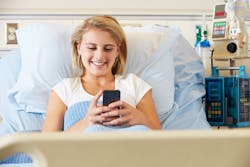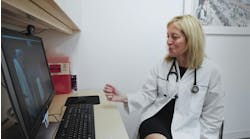One of the many unfortunate outcomes of the COVID-19 pandemic is that hospital patients and their families very often can’t physically communicate with each other. With hospitals restricting visitors for safety reasons, patients’ loved ones are left waiting and wondering about health statuses. At Health First, a Brevard County, Fla.-based community healthcare system, senior leadership turned to technology to help fill this gap and connect patients with their families.
Between April 15 and Oct. 2 of last year, Health First’s Holmes Regional Medical Center sent nearly 19,000 secure messages to patients’ loved ones across 49 states by leveraging a mobile app from clinical communication solutions company Vocera. The Vocera Ease application was deployed in four Central Florida hospitals to improve patient and family communication, and the cloud-based platform enables nurses and other healthcare professionals to send secure texts, photos and video updates to a patient’s designated loved ones during a hospital stay or medical procedure. Family members and friends can respond to updates with emojis, giving immediate feedback and support to caregivers.
From the 19,000 messages sent in the six-month window last year, families and friends responded to care teams with more than 26,000 emojis, including 13,000 thumbs-ups, 8,000 hearts and 4,500 prayer hands, according to Vocera officials.
What’s more, Health First can track patient and family experience in real-time using the customizable in-app survey. Based on operating room survey results between April and October 2020 at Holmes Regional Medical Center, 97 percent of respondents indicated the hospital demonstrated compassion and caring by offering the Ease app to patients and families. Additionally, 97 percent said they would recommend the hospital to others based on their experience with the application.
In addition to Holmes Regional Medical Center, Health First’s Cape Canaveral Hospital, Health First’s Palm Bay Hospital and Health First’s Viera Hospital use the Ease application in operating rooms (OR) and newborn intensive care units (NICU). As such, care teams can send secure updates from the OR, NICU, ICU, radiology, the emergency room, and other inpatient and outpatient areas. The HIPAA-compliant messages, pictures and videos disappear 60 seconds after being viewed, and nothing is saved on the mobile device, providing an additional layer of security and privacy, according to officials.
“Even during the best of times, a hospital stay can cause anxiety for patients and their families. Not only are they dealing with a medical procedure, but they often can’t be together in the hospital. Seeing a reassuring picture of grandma or a newborn family member provides needed comfort,” says Mark Rosenbloom, M.D., vice president of clinical transformation at Health First. Rosenbloom recently spoke further about using the application and its importance during the crisis with Healthcare Innovation. Below are excerpts of that discussion.
Can you discuss Health First’s motivation for leveraging this communication tool? Was it put into place pre-COVID?
About two years ago, I was the vice president of medical affairs in our large tertiary hospital. We were having a medical staff retreat, and a lot of the conversation was around improving the patient experience. Our medical staff president at the time had introduced us to Ease [Ease Applications was purchased by Vocera in August 2020], and we were all quite fascinated by what Ease could do. We really hadn't seen anything like that before. Shortly after that, our healthcare system began to pivot to what we call being “more consumer-centric.” Part of that was taking a look at how operating rooms were functioning from the consumer standpoint, and we felt that a product like Ease would be a great fit into that project. From there, we started the pilot program at our large hospital, and subsequently, it has been expanded to all four hospital operating rooms and all four hospital cardiac catheterization labs. In addition, we have a neonatal intensive care unit at our tertiary hospital, and we instituted it there as well.
It began for patients having surgery. So everybody who's coming in for an operation is offered the opportunity, ahead of time, to sign up for the Ease application to enter the loved ones who they want to contact [during the patient stay]. It’s [essentially] offered to anybody having surgery, whether they're outpatients or inpatients, and we basically apply that same principle to family members, parents with children in the NICU, and now, also to those folks who are having procedures in the cardiac catheterization lab.
Can you compare this to other communication solutions you have tried in the past?
I would say our [previous] tool was the telephone. I practiced vascular surgery for 28 years, and I always made it a point to have the nurse call out to the waiting room to let the patient's family know that we have started [the procedure], and if anything was taking longer, we would call out to them. And of course when I was done, I would come talk to the family. Patients loved that, but there's really no scale there; I can't send a message to the patient's family all over the country. I can't send a picture or video. So this app was quite transformational since we have just been relying on telephone calls to the patients’ families in the past.
What has the feedback from this application been like?
The greatest value has been in how patients and families feel about getting this information, and being part of the process, even if they can't be here with their loved ones. We have gotten [tens of thousands] messages back, including heart emojis and thank you emojis, that indicate the families really appreciate being a part of this. We’re also measuring things like the outpatient and ambulatory surgery CAHPS [Consumer Assessment of Healthcare Providers and Systems] scores, and the communication scores are in the 85th and 95th percentile. Those are not scores that we've seen in the past.
Due to the pandemic, do you see communication tools like this becoming more of the norm down the road?
COVID is not anything like we've ever seen before, but it has caused probably us to speed up a lot of innovation that may have taken a lot longer in a very short period of time. Lots of genies are out of the bottle and they’re not going back in. This is just another example. We had to do this because families couldn’t see their loved ones, so, yes, I think we'll probably start to see more innovation in this area in the coming months and years. And for me, as a practitioner for many years, this has been the most consumer-centric thing that I've seen. I would have loved to have been able to use this if I had still been in practice.


